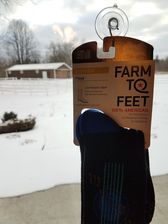
Recently I took a snowboarding trip to Utah and needed to do a little pre-trip shopping. For someone with such an interest in outdoor gear I’m not one of those people with a garage full of goodies. The most sustainable piece of outdoor gear is the one you DON’T buy. But the couple pair I had were so stretched out from years of use that it was finally time to bite the bullet. So I went to REI and picked up a pair of Farm to Feet socks.
The sustainability story at Farm to Feet is overwhelmingly focused on Made in the United States. Sustainability is such a fluid concept with very few absolutes about which strategy is better than another in the inevitable give-and-take world of business, and I think this company brings up some interesting topics.
The sustainability story at Farm to Feet is overwhelmingly focused on Made in the United States. Sustainability is such a fluid concept with very few absolutes about which strategy is better than another in the inevitable give-and-take world of business, and I think this company brings up some interesting topics.
- For instance, the wool in their socks is made from American sheep. The good part is that the greenhouse gases from transportation for their raw materials from farm to manufacturing is low, and it supports American farmers. But they don’t address animal welfare, in particular the act of mulesing (Info on Responsible Wool). This may be more than you ever wanted to know about sheep butts, but this painful practice involves cutting away the skin around their anus so the hair doesn’t collect feces and attract flies that cause disease. It is a practice that has alternatives that are starting to become more common, but it is not addressed by either the manufacturer or the American Wool Council they refer to on the website.
- 100% U.S. Nylon and Spandex: Again, I think it’s great that they are sourcing locally, but what is the nylon and spandex made from? The positive is less greenhouse gases from American production and resulting American jobs, but it’s most likely made from traditional sources of petroleum.
- Paperboard and inks used in packaging are made in the USA as well, but the content itself isn’t addressed. If it’s virgin wood pulp from old growth forests with toxic inks, then that isn’t really helping too much.
- They also don’t address the dyeing process, one which is inevitably filled with a variety of toxic chemicals that can pollute the waterways around the factories and subject employees to off-gassing from working around the chemicals everyday.

 RSS Feed
RSS Feed